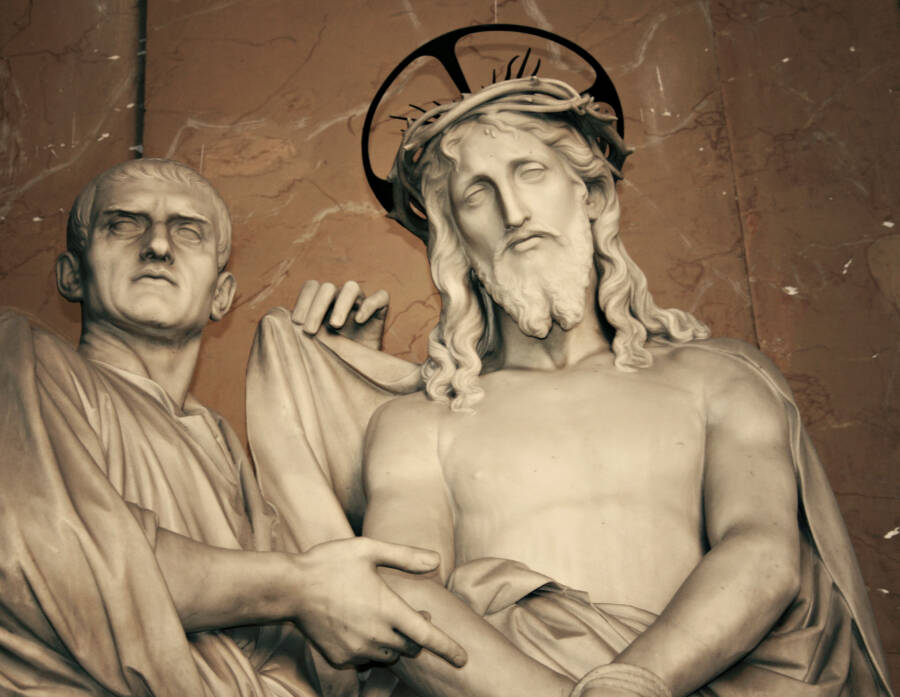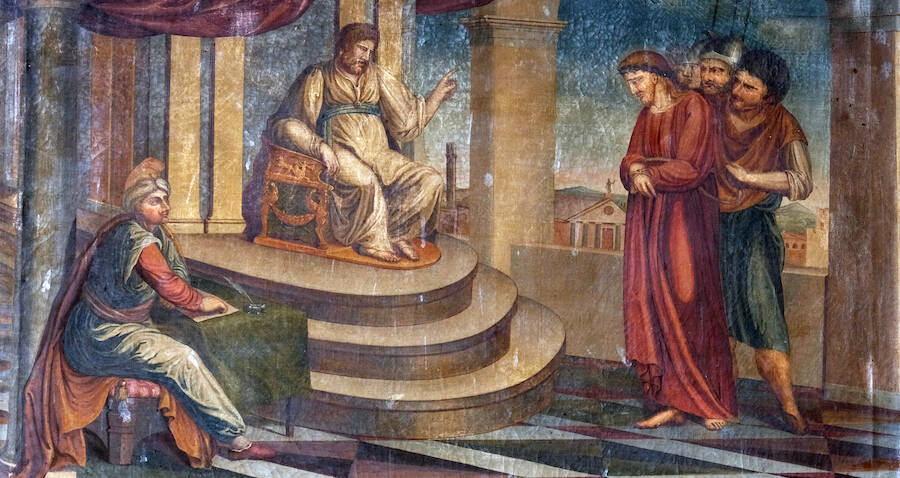Blog
The Mysterious Life of the Roman Governor Who Ordered Jesus’ Crucifixion
Pontius Pilate is best known as the man who sentenced Jesus Christ to death, but his life and legacy are surrounded by controversy and mystery in both the Bible and historical records.
Pilate served as the Roman governor of Judaea (now part of Palestine and Israel) for about ten years. While his role in the crucifixion of Jesus has made him infamous, there are many aspects of his life that remain shrouded in mystery.
Historical accounts and biblical descriptions of Pilate are often contradictory. Some portray him as a ruthless tyrant indifferent to the laws and feelings of his subjects, while others depict him as a volatile and impulsive leader. Even the circumstances surrounding his sentencing of Jesus are cloaked in ambiguity.
Pontius Pilate as Governor of Judaea
Pontius Pilate served as the fifth Roman governor of Judaea from AD 26 to 36 under Emperor Tiberius. However, little is known about his life before he assumed this role.
Historical documents suggest that Pilate may have been born in Italy and came from an equestrian family, part of the Roman aristocracy. It is believed that he joined the military, partly based on his name. The Biblical Archaeology Society reports that “Pilatus” (Pilate in Greek) means “armed with a spear,” indicating he may have served as a skilled spear-thrower in the military.
Scholar Warren Carter, in his book “Pontius Pilate: Portraits of a Roman Governor,” suggests that Pilate likely had a distinguished military career and belonged to the Roman elite, with a wealthy family background.
During his ten-year tenure as governor, Pilate was responsible for collecting taxes and overseeing construction projects in Judaea. However, he is most famously known for maintaining law and order in the region.
Despite holding power alongside a Jewish council, historians believe Pilate had a tumultuous relationship with the people he governed. According to Flavius Josephus, a first-century Jewish-Roman historian, Pilate angered the local Jews by ordering the placement of Caesar’s images in Jerusalem, violating their customs.
Josephus wrote that Pilate intended to break Jewish customs by introducing emperor busts into the city, despite Jewish laws against such images. When locals protested, leading to five days of riots, Pilate ordered his soldiers to surround the demonstrators and threatened to kill them if they did not stop. The Jews’ willingness to die rather than see their laws violated forced Pilate to remove the images.
Josephus also reported that Pilate offended the Jews again by using Temple funds to build an aqueduct to Jerusalem. When a crowd gathered to confront him, Pilate had his soldiers brutally beat them until they dispersed or died.
The Gospel of Luke recounts another instance of Pilate’s brutality, stating: “Some people told Jesus about the Galileans whose blood Pilate had mixed with their sacrifices.”
Historical records clearly depict Pilate as a harsh and sometimes cruel ruler, ready to use force to ensure obedience. Yet, many biblical texts suggest a more empathetic side to Pilate, despite his role in Jesus’ execution. Some Christian churches even venerate the Roman governor as a saint.
The Trial and Crucifixion of Jesus

According to the Gospels, the Sanhedrin arrested Jesus because they felt threatened by his teachings and his claim to be the “King of the Jews,” which they viewed as blasphemy and treason.
The soldiers brought Jesus before Pontius Pilate for trial. Pilate was reluctant to sentence Jesus and appeared conflicted and indecisive in his judgment, as depicted in the Gospels.
“What charges do you bring against this man?” Pilate asked the Sanhedrin. The Jewish council responded, “If he were not a criminal, we would not have handed him over to you.”
Finding no legal basis to condemn Jesus to death, Pilate tried to avoid responsibility by telling the Jewish elders, “Take him yourselves and judge him by your own law.” However, they refused, insisting that Pilate, who alone had the authority to impose a death sentence, should execute Jesus.
According to the New Testament, under pressure from the Jewish leaders, Pilate eventually acquiesced to their demands and ordered Jesus’ crucifixion. It is said that Pilate symbolically washed his hands before the Jewish council, refusing to accept responsibility for Jesus’ death and placing the blame on the Jews.
The historian Matthew wrote, “When Pilate saw that he was getting nowhere, but that instead an uproar was starting, he took water and washed his hands in front of the crowd, saying, ‘I am innocent of this man’s blood; see to it yourselves.'”
Pilate then reportedly ordered the inscription “Jesus of Nazareth, King of the Jews” to be placed on Jesus’ cross. Some interpret this as mockery, while others believe Pilate genuinely saw Jesus as the King of the Jews.
The Mysterious Later Years of Pontius Pilate
According to “The Letters of Herod and Pilate,” a collection of letters exchanged between Pontius Pilate and King Herod, Pilate was tormented by guilt after Jesus’ crucifixion.
In one letter, Pilate speaks of encountering the resurrected Jesus and repenting for his role in Jesus’ death. “When we saw Him, we all fell prostrate at His feet. And I cried aloud, ‘I have sinned… I know that He is Lord, Son of God, and I have seen His humanity, not His divinity. But King Herod and the people of Israel compelled me to do evil to the King. Therefore, have mercy on me, O Lord of Israel!'”
Though many scholars doubt the authenticity of these letters, they explore the theory that Pilate converted to Christianity and became a devout follower of Jesus after the crucifixion.
More reliable historical records indicate that Pilate was dismissed from his position after allegedly massacring a group of Samaritans who were climbing a mountain in search of sacred artifacts they believed Moses had buried there.
Pilate was summoned to Rome to explain his actions to the Roman Emperor.
Historians are uncertain whether he safely returned from Rome. If he did, it is likely the emperor either dismissed him from his post or Pilate retired voluntarily, as he never returned to govern Judaea.
Some sources suggest Pilate converted to Christianity, while others propose a darker end. Some believe Emperor Caligula executed Pilate, while others claim he was exiled and died by suicide.

